The Star Cavalier was an American two-seat high-wing light aircraft first introduced in the late 1920s.
The Star Cavalier was an American two-seat high-wing light aircraft first introduced in the late 1920s.

The Star Aircraft division of Phillips Petroleum was formed at Bartlesville, Oklahoma in 1928. Designers E.A.Riggs and W.Parker prepared plans for a two-passenger high-wing light private owner aircraft intended for the lower cost end of the market. The advertised cost was $3,450. Three Cavalier A planes were delivered in 1928.
The Cavalier B followed in 1929 fitted with a lower powered 55 hp Velie M-5 engine and 15 examples were sold at $2,895 to owners of more modest means. Single examples of the Cavalier C and D followed. The next to secure modest success was the Cavalier E of 1930 which had a 90 h.p. Lambert and was fitted with a taller, more angular, tail fin. 13 were sold. The last of the Cavalier series was the single F model. [1]
The various Cavalier models served private owners in the touring role until the curtailment of civil flying in the US in late 1941. Five Cavaliers remained on the U.S. civil aircraft register as of 2009. Cavalier B N14860 of 1930 is on public display, in airworthy condition, at the Historic Aircraft Restoration Museum at Dauster Field, Creve Coeur, Missouri near St Louis. [2]

(source - Aerofiles)
Data from Aerofiles and The Incomplete Guide to Airfoil Usage [4]
General characteristics
Performance

The Monocoupe 90 was a two-seat, light cabin airplane built by Donald A. Luscombe for Monocoupe Aircraft. The first Monocoupe was built in an abandoned church in Davenport, Iowa, and first flew on April 1, 1927. Various models were in production until the late 1940s.

The Aeronca L was a 1930s American cabin monoplane designed and built, in small numbers, by Aeronca Aircraft. It differed significantly from other Aeronca planes by the use of radial engines, streamlining, and a cantilever low wing.
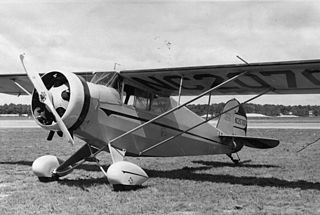
The Porterfield Model 35 Flyabout was an American two-seat cabin monoplane built by the Porterfield Aircraft Corporation of Kansas City.
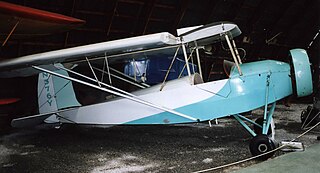
The Nicolas-Beazley NB-8G is a United States two-seat parasol wing light monoplane that was constructed in the early 1930s.
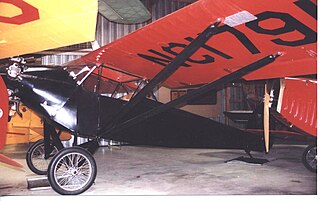
The Mono Aircraft Monoprep was an American light civil sporting monoplane of the late 1920s.

The Waco 9 is an American-built three-seat biplane design that first flew in 1925.
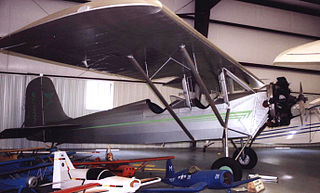
The Timm Collegiate was a series of American-built two-seat light aircraft of the late 1920s.

The Stout Skycar was a series of four one-off American light aircraft of the 1930s.

The Swallow Airplane Swallow is an American-built general purpose biplane of the mid- to late 1920s.
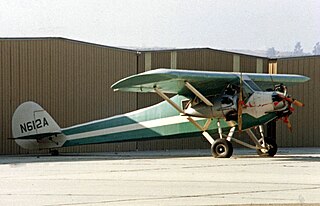
The Kreutzer Air Coach is an American-built light trimotor transport aircraft of the late 1920s.
The Kadiak KC-2 Speedster is an American single-seat, radial engined homebuilt biplane designed prior to World War II.
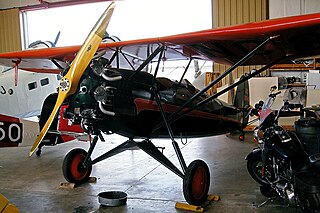
The Davis D-1 is an American light two-seat parasol-winged monoplane of the late 1920s.
The Mercury Chic T-2 was a lightweight American parasol wing monoplane designed and built by the Mercury Aircraft Inc. in the late 1920s. Flown for the first time in 1928, about 27 were built, but due to the early 1930s economic depression only 15 were sold, and the rest were scrapped.
The St. Louis C2 Cardinal family are a series of light sport monoplanes built by the St. Louis Aircraft Corporation during the peak of the Lindbergh Boom after the Spirit of St. Louis flight of 1927.
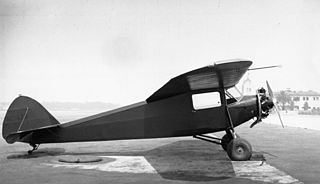
The Kari-Keen 90 Sioux coupe was a two-seat cabin monoplane.

The Nicholas-Beazley NB-3, or Barling NB-3, is a two-seat, training aircraft of the 1920s.
The Invincible D-D was a prototype three/four seat touring aircraft, built in the US in 1929. One example flew but development was ended by the Great Depression.
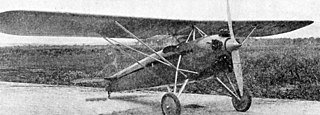
The Inland Sport series of parasol wing, sport and training side-by-side two seaters, introduced between 1928 and 1930, differed chiefly in their engines. They used three different radial engines, more than doubling the Sport's power over two years of development. 34 examples were built and frequently re-engined.
The Watkins Skylark was an American low-wing, cantilever two-seater designed for private and club use. A large anticipated production run in 1930 ended early when the company collapsed in the Great Depression, with only five or six registered.
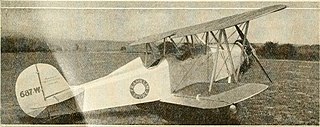
The Franklin Sport is a two seat sport and training biplane built in the U.S. in 1930. Several different engines, in the power range 55–90 hp (41–67 kW), were fitted. Two remained airworthy in 2011.
| Wikimedia Commons has media related to Star Cavalier . |